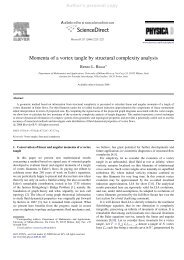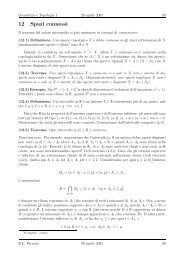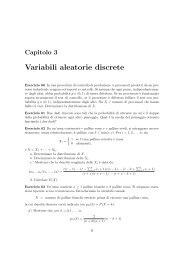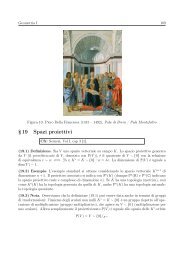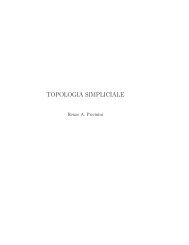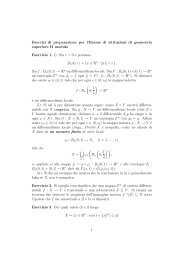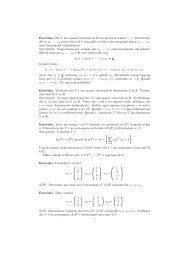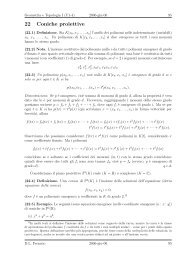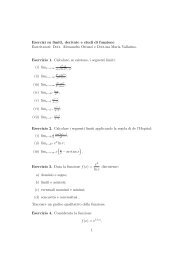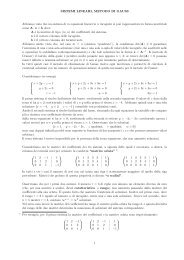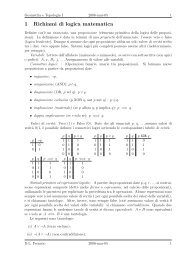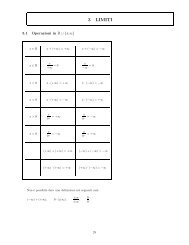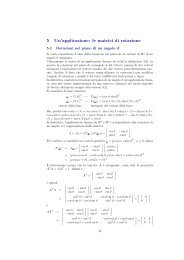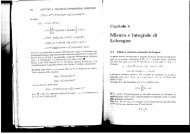Sezione F7 Meccanica del continuo
Sezione F7 Meccanica del continuo
Sezione F7 Meccanica del continuo
You also want an ePaper? Increase the reach of your titles
YUMPU automatically turns print PDFs into web optimized ePapers that Google loves.
<strong>Sezione</strong> <strong>F7</strong><br />
<strong>Meccanica</strong> <strong>del</strong> <strong>continuo</strong><br />
D. Ambrosi, <strong>Meccanica</strong> <strong>del</strong>la crescita: continui monocomponente e miscele<br />
D. Bambusi, Metodi di forma normale in equazione a derivate parziali<br />
I. Barbieri, Fenomeni ondulatori in biologia<br />
V. Berti, Risultati di esistenza e unicità per un’equazione integro-differenziale con nucleo<br />
di memoria singolare<br />
S. Carillo, Minimum free energy in heat condition: materials with memory<br />
C. Cattani, Cubic nonlinear waves in elastic materials<br />
G. Caviglia, Riflessione e trasmissione in solidi anisotropi stratificati: esistenza e unicità<br />
P. Cermelli, Renormalized energy and forces on dislocations<br />
A. Lovinson, Funzioni generatrici globali a finiti parametri in teoria dei campi<br />
F. Mainardi, Risultati recenti per l’equazione <strong>del</strong>la diffusione frazionaria<br />
P. M. Mariano, Hamiltonian structures in multifield theories of complex materials<br />
M. S. Mongiovì, Su un mo<strong>del</strong>lo macroscopico <strong>del</strong>la turbolenza quantistica<br />
M. G. Naso, Controllo <strong>del</strong>le vibrazioni in una piastra termoelastica mediante sorgenti<br />
di calore<br />
M. Padula, Lyapunov method applied to nonlinear hyperelastic and linearly viscous<br />
bodies<br />
L. Palese, A linear magnetic Benard problem with hall and ion-slip effects<br />
F. Pastrone, Non linear waves in approximately constrained materials<br />
S. Polidoro, Decadimento esponenziale per le equazioni di Maxwell con memoria al<br />
bordo<br />
L. Restuccia, Material forces in inhomogeneous ferroelectric crystals<br />
E. Scarpetta, Analytical results for scattering problems in wave propagation<br />
G. Tomassetti, Equazioni di evoluzione di una parete di dominio in un corpo ferromagnetico<br />
indeformabile
XVII Congresso U.M.I.<br />
Milano, 8-13 settembre 2003<br />
<strong>Meccanica</strong> <strong>del</strong>la crescita: continui<br />
monocomponente e miscele<br />
D. Ambrosi, A. Farina, L. Fusi<br />
Dipartimento di Matematica “U. Dini”, Università degli Studi di Firenze<br />
I tessuti biologici sono caratterizzato dal fatto che crescono, aumentano e diminuiscono<br />
continuamente la loro massa. La crescita dei tessuti molli non e’ di tipo superficiale,<br />
come avviene per le ossa, ma volumetrico. Diverse recenti osservazioni sperimentali hanno<br />
mostrato che questa dipende in modo complesso dallo sollecitazioni meccaniche a cui e’<br />
sottoposto il materiale. Una descrizione matematica <strong>del</strong>la loro meccanica raramente puó<br />
prescindere da una conoscenza <strong>del</strong>la loro dinamica di crescita.<br />
Da un punto di vista matematico questa fenomenologia è un caso particolare <strong>del</strong>la <strong>del</strong><br />
problema di mo<strong>del</strong>lizzare la crescita di un mezzo <strong>continuo</strong>. In questa comunicazione si<br />
discuterà l’efficacia di una decomposizione moltiplicativa <strong>del</strong> gradiente di deformazione<br />
in due contributi, uno che renda conto <strong>del</strong>la crescita, l’altro che descriva le proprietà<br />
meccaniche <strong>del</strong> corpo. In particolare, verranno discussi i legami tra gradiente di crescita<br />
e tasso di crescita, il ruolo <strong>del</strong>l’equazione di bilancio <strong>del</strong>l’energia e la possibilità di trarre<br />
restrizioni sulle relazioni costitutive a partire da opportuni principi. La teoria sviluppata<br />
nel caso monocomponente può essere estesa a miscele in cui una <strong>del</strong>le due componenti<br />
sia un solido elastico. Si mostreranno infine alcuni risultati numerici di simulazioni in<br />
geometrie semplici.<br />
Corso Duca degli Abruzzi 24, 10129 Torino.<br />
E-mail address: ambrosi@calvino.polito.it<br />
Viale Morgagni 67/A, 50134 Firenze, Italy<br />
E-mail address: angiolo.farina@math.unifi.it, fusi@math.unifi.it<br />
1991 Mathematics Subject Classification. Classificazione AMS.<br />
Questa ricerca è stata parzialmente finanziata dall’INDAM-GNFM.
XVII Congresso U.M.I.<br />
Milano, 8-13 settembre 2003<br />
Metodi di forma normale in<br />
equazione a derivate parziali<br />
Dario Bambusi<br />
Dipartimento di Matematica, Universita’ degli studi di Milano<br />
Si intende esporre una recente generalizzazione <strong>del</strong>la teoria <strong>del</strong>le forme normali a equazioni<br />
a derivate parziali iperboliche, mettendo in evidenza come essa permetta di descrivere<br />
qualitativamente le soluzioni di tali equazioni. Si metteranno in evidenza importanti differenze<br />
tra il caso semilineare e quasilineare. Ci si propone di illustrare anche alcune<br />
applicazioni a MHD e altri mo<strong>del</strong>li descriventi la dinamica di corpi continui.<br />
Via Saldini 50, 20133 Milano<br />
E-mail address: Bambusi@mat.unimi.it<br />
1991 Mathematics Subject Classification. 37K55.<br />
Il lavoro è stato parzialmente finanziato dal MIUR, Progetto COFIN2001 “Dinamica dei sistemi classici<br />
Hamiltoniani, fondamenti dinamici <strong>del</strong>la meccanica statistica e dinamica <strong>del</strong>l’interazione radiazione<br />
materia”
XVII Congresso U.M.I.<br />
Milano, 8-13 settembre 2003<br />
FENOMENI ONDULATORI IN BIOLOGIA<br />
I. Barbieri ∗ , L. Colì ◦ , F. Melloni ∗ , G. Pallotti ◦ , P. Pettazzoni ◦ , S. Stefoni ◦<br />
Università di Bologna “Alma Mater Studiorum”,<br />
∗ Facoltà di Scienze MM.FF.NN. – ◦ Facoltà di Medicina e Chirurgia<br />
I fenomeni periodici regolano il mondo <strong>del</strong>la Biologia, in primo luogo il corpo umano<br />
sviluppa nel suo interno fenomeni costantemente ondulatori.<br />
I periodi che si presentano variano in funzione di quelle che sono le attività che debbono<br />
essere svolte e dei diversi organi deputati ad esse; ogni cellula <strong>del</strong> nostro corpo ha un suo<br />
processo armonico che svolge e quindi quando viene generata nasce con una sua particolare<br />
caratteristica di funzione periodica.<br />
In questo lavoro saranno presentati quelli che sono i problemi <strong>del</strong>l’onda sfigmica e <strong>del</strong>la<br />
biomeccanica ad essi connessi.<br />
Il cuore genera l’onda sfigmica dando con ciò origine ad un’oscillazione forzata, necessaria<br />
per far scorrere il sangue in tutto il circuito cardiovascolare e quindi ossigenare i<br />
tessuti per permettere la loro sopravvivenza.<br />
I fenomeni di trasmissione <strong>del</strong>l’onda sfigmica nel corpo umano sono retti dalle leggi che<br />
furono messe in evidenza da Max Anliker che rilevò inoltre l’importanza che rivestono i<br />
tessuti molli <strong>del</strong>l’intera struttura umana.<br />
Oltre a quella che è l’esposizione <strong>del</strong> processo dal punto di vista teorico, verrà considerato<br />
anche l’effetto che viene ad aversi a livello pratico e clinico.<br />
E-mail address: barbieri@dm.unibo.it, pallotti@DF.UNIBO.IT
XVII Congresso U.M.I.<br />
Milano, 8-13 settembre 2003<br />
Risultati di esistenza e unicità per un’equazione<br />
integro-differenziale con nucleo di memoria singolare<br />
Valeria Berti<br />
Università di Bologna<br />
L’evoluzione di un solido viscoelastico lineare è descritta dall’equazione differenziale<br />
(1) ü(x, t) = ∇ · T (x, t) + f(x, t),<br />
in cui il tensore degli sforzi T soddisfa l’equazione costitutiva<br />
T (x, t) = G ∞ (x)∇u(x, t) −<br />
∫ ∞<br />
0<br />
G ′ (x, s)[∇u(x, t) − ∇u(x, t − s)]ds ,<br />
Nelle trattazioni classiche, si assume che il nucleo di memoria G ′ sia una funzione L 1 <strong>del</strong><br />
tempo. Tuttavia il comportamento di alcuni materiali viscoelastici può essere descritto da<br />
un mo<strong>del</strong>lo in cui il nucleo presenta una singolarità iniziale.<br />
In questa presentazione verrà considerato il caso in cui G ′ /∈ L 1 , ma una sua primitiva<br />
sia integrabile nell’origine.<br />
La ricerca <strong>del</strong>le soluzioni deboli <strong>del</strong>l’equazione (1) porta all’introduzione di uno spazio<br />
funzionale dipendente esplicitamente dalle proprietà <strong>del</strong> nucleo di memoria. Sotto opportune<br />
ipotesi di regolarità <strong>del</strong>le sorgenti, si dimostra un teorema di esistenza e unicità<br />
<strong>del</strong>la soluzione <strong>del</strong> problema evolutivo. Tale risultato è ottenuto utilizzando il metodo <strong>del</strong>la<br />
trasformata di Fourier per ricercare le soluzioni nel dominio <strong>del</strong>le frequenze e riconducendo<br />
il sistema integro-differenziale originario alla determinazione <strong>del</strong>le soluzioni di un problema<br />
ellittico con frequenza fissata.<br />
Dipartimento di Matematica, P.zza Porta San Donato 5, 40126 Bologna.<br />
E-mail address: berti@dm.unibo.it<br />
1991 Mathematics Subject Classification. Classificazione AMS: 74D05, 74H20, 74H25.
Minimum free energy in heat conduction:<br />
materials with memory 1<br />
Sandra Carillo<br />
Dipartimento di Metodi e Mo<strong>del</strong>li Matematici per le Scienze Applicate, Università di<br />
Roma “La Sapienza”, I-00161 Rome, Italy<br />
The minimum free energy is obtained in the cases of a rigid linear heat conductor with<br />
memory. Thus, the result is compared with results concerning the minimum free energy<br />
in isothermal viscoelasticity. Interesting similarities can be observed when such results<br />
are compared. In addition, in both the cases, the minimum free energy is related to<br />
the maximum recoverable work. The mo<strong>del</strong> of rigid heat conductor here adopted is that<br />
one comprised in Fabrizio, Gentili and Reynolds [3] where the thermodynamics of a rigid<br />
omogeneous linear heat conductor with memory is studied. The results concerning the<br />
minimum free energy in this framework have been recently studied [1]; they are compared<br />
with results in the study of isothermal viscoelasticity. In particular, results here referred<br />
to have been obtained by Fabrizio and Golden [4], Fabrizio, Deseri, Gentili and Golden<br />
[2], Golden [6], Gentili [5], where, in addition, historical notes as well as many references<br />
on the study of isothermal viscoelasticity are comprised.<br />
E-mail address: carillo@dmmm.uniroma1.it<br />
References<br />
[1] S. Carillo: A rigid linear heat conductor with memory: minimum free energy, preprint<br />
Dipartimento di Metodi e Mo<strong>del</strong>li Matematici, Universita‘ di Roma “La Sapienza”,<br />
2003.<br />
[2] L. Deseri, G. Gentili, J.M. Golden: An Explicit Formula for the Minimum Free Energies<br />
in Linear Viscoelasticity, J. Elasticity, 54, p. 141-185, 1999.<br />
[3] M. Fabrizio, G. Gentili, D.W.Reynolds: On rigid heat conductors with memory, Int.<br />
J. Eng. Sci. , 36, p. 765–782, 1998.<br />
[4] M. Fabrizio, J.M. Golden: Maximum and minimum free energies for a linear viscoelastic<br />
material, Quart. Appl. Math., 60, no. 2, p. 341–381, 2002.<br />
[5] G. Gentili: Maximum recoverable work, minimum free energy and state space in linear<br />
viscoelasticity, Quart. Appl. Math., 60, no. 1, p. 153–182, 2002.<br />
[6] J. M. Golden: Free energies in the frequency domain: the scalar case, Quart. Appl.<br />
Math., 58, p. 121–150, 2000.<br />
1<br />
Classificazione AMS 80A20, 74F05<br />
Under the support of G.N.F.M.-I.N.D.A.M. and of M.I.U.R., Progetto Cofinanziato 2002 Mo<strong>del</strong>li Matematici<br />
per la Scienza dei Materiali<br />
1
XVII Congresso U.M.I.<br />
Milano, 8-13 settembre 2003<br />
Cubic Nonlinear Waves in Elastic Materials<br />
Carlo Cattani<br />
Università di Roma “La Sapienza”,<br />
Sunto The lecture is devoted to cubic nonlinearity of hyperelastic waves in materials and deals with: 1)<br />
Cubic nonlinear wave equations for hyperelastic plane waves in materials; 2) Third harmonics generation<br />
by initially excited harmonic longitudinal wave; 3) New simple waves generation by initially excited simple<br />
longitudinal wave. Especial attention is payed to simple waves and similarity between new harmonic and<br />
simple waves generation. Some peculiarities of using the wavelets analysis to revealed wave effects are<br />
discussed.<br />
It is shown that cubic nonlinearity and nonlinearities of higher order follow naturally from classical<br />
nonlinear acoustics approach and should be considered equally important compared with the quadratic<br />
nonlinearity. Cubic non-linearity is wi<strong>del</strong>y discovered and investigated<br />
surface waves in fluids.<br />
in the theory of internal and<br />
Nonlinear deformations are realized in classical theory using the Murnaghan elastic potential<br />
W (ɛ ik) ) = 1 2 λ(ɛ mm) 2 + µ(ɛ ik ) 2 +<br />
+ 1 3 Aɛ ikɛ im ɛ km + B(ɛ ik ) 2 ɛ mm + 1 3 C(ɛ mm) 3 . (1)<br />
Here λ, µ are Lame elastic constants, A, B, C are Murnaghan elastic constants, ɛ ik = 1 2 (u i,k + u k,i +<br />
u m,i u m,k ) is the nonlinear Green strain tensor.<br />
The Murnaghan potential describes a broad class of materials, is basic in mechanics of materials and<br />
wi<strong>del</strong>y used. The Murnaghan representation, usually noted as cubic, relatively to the strain tensor is<br />
W quad = 1 (<br />
2 λ( ) 2 1<br />
u m,m +<br />
4 µ( ) 2<br />
u i,k + u k,i + µ + 1 )u<br />
4 A i,k u m,k u m,i +<br />
+ 1 ( ) ( ) 2 1<br />
λ + B um,m ui,k +<br />
2<br />
12 Au i,ku k,m u m,i +<br />
+ 1 2 Bu i,ku k,i u m,m + 1 3 C( u m,m<br />
) 3. (2)<br />
This form preserves the initial cubic nonlinearity, but already not on the strain tensor. Owing to nonlinearity<br />
of the Green strain tensor, the complete representation of the Murnaghan potential will include<br />
summands from the second to the sixth orders relatively to the gradient. All these terms will be taken<br />
into account, coming into the third and more orders nonlinearities in material deformations.<br />
Dipartimento di Matematica “G.Castelnuovo”,<br />
Università di Roma “La Sapienza”,<br />
P.le A. Moro 5, I-00185 Rome<br />
E-mail address: carlo.cattani@uniroma1.it
XVII Congresso U.M.I.<br />
Milano, 8-13 settembre 2003<br />
Riflessione e trasmissione in solidi anisotropi<br />
stratificati: esistenza e unicità<br />
G. Caviglia e A. Morro<br />
Università di Genova<br />
Si considera uno strato solido di spessore finito, con parametri materiali variabili con<br />
continuità lungo una direzione assegnata n. Lo strato è compreso fra due semispazi (solidi)<br />
omogenei; in generale, i piani di contatto sono superfici di discontinuità dei parametri<br />
materiali. Si suppone che i solidi siano viscoelastici lineari anisotropi. Essendo assegnata<br />
un’onda che incide sullo strato, si esamina il problema <strong>del</strong>la riflessione-trasmissione.<br />
Nel dominio <strong>del</strong>le trasformate di Fourier, si sceglie la dipendenza dalle coordinate<br />
trasversali e dal tempo tipica <strong>del</strong>le onde piane, mo<strong>del</strong>lando così l’effetto di onde incidenti<br />
oblique. In queste ipotesi le equazioni di propagazione sono scritte nella forma di<br />
un sistema di sei equazioni differenziali ordinarie <strong>del</strong> primo ordine, lineari, a coefficienti<br />
complessi, nel quale sono incognite le componenti <strong>del</strong>lo spostamento e <strong>del</strong>la trazione sui<br />
piani ortogonali alla direzione <strong>del</strong>la stratificazione, n.<br />
Si associa ad ogni onda uno scalare, F, che rappresenta il flusso di energia per unità<br />
di tempo e per unità di superficie perpendicolare ad n. Come conseguenza <strong>del</strong> secondo<br />
principio <strong>del</strong>la termodinamica si dimostra che F decresce durante la propagazione nel caso<br />
di solido viscoelastico e che si mantiene costante nel caso di solido elastico. Si dimostra<br />
inoltre che F è generato da una matrice hermitiana Φ avente tre autovalori positivi e<br />
tre autovalori negativi. Mediante gli autovettori di Φ associati agli autovalori positivi<br />
(negativi) si definiscono i tre generatori <strong>del</strong>le onde che si propagano in avanti (all’indietro)<br />
rispetto al verso di n, essendo inteso che il verso di propagazione di un’onda è determinato<br />
dal segno <strong>del</strong> corrispondente flusso di energia F.<br />
Rappresentando in termini di generatori le onde incidente (assegnata), riflessa (incognita)<br />
e trasmessa (incognita) e sfruttando la proprietà <strong>del</strong> flusso F si dimostra un teorema<br />
di esistenza e unicità per il problema <strong>del</strong>le riflessione e trasmissione.<br />
E-mail address: caviglia@dima.unige.it<br />
1991 Mathematics Subject Classification. Classificazione AMS: 74J20, 74D05.<br />
La ricerca che ha condotto a questo lavoro è stata svolta nell’ambito <strong>del</strong> Progetto di Ricerca COFIN<br />
2002 “Mo<strong>del</strong>li Matematici per la Scienza dei Materiali” <strong>del</strong> MIUR.
XVII Congresso U.M.I.<br />
Milano, 8-13 settembre 2003<br />
Renormalized energy and forces on dislocations<br />
Paolo Cermelli ∗ and Giovanni Leoni ∗∗<br />
(∗) Dipartimento di Matematica, Universita’ di Torino, (∗∗)<br />
Department of Mathematical Sciences, Carnegie-Mellon University.<br />
The goal of this work is to give a variational formulation of the equilibrium problem for<br />
a finite number of screw dislocations in a cylindrical domain, give a representation of the<br />
renormalized energy and discuss its relation with the configurational forces (the Peach-<br />
Köhler force) on the dislocations. The results obtained in this paper may provide the basis<br />
to study the relations between discrete and continuum theories of dislocations, in order to<br />
characterize ’ab initio’ the macroscopic constitutive relations of defective materials.<br />
(∗) Via C. Alberto 10, 10123 Torino, Italy, (∗∗) Pittsburgh, PA 15213, USA<br />
E-mail address: (∗) paolo.cermelli@unito.it, (∗∗) leoni@math.cmu.edu<br />
1991 Mathematics Subject Classification. 74-xx, 49-xx.<br />
Progetto Cofin 2002: ”Mo<strong>del</strong>li Matematici per la Scienza dei Materiali” .
XVII Congresso U.M.I.<br />
Milano, 8-13 settembre 2003<br />
Funzioni generatrici globali<br />
a finiti parametri<br />
in teoria dei campi<br />
Alberto Lovison<br />
Dipartimento di Matematica Pura ed Applicata<br />
Consideriamo il principio variazionale di Volterra-Vainberg per un problema quasi lineare<br />
con condizioni al bordo di Dirichlet:<br />
{ N(u) = Lu − εF (u) = 0 in Ω<br />
u| ∂Ω = 0<br />
⇐⇒<br />
dJ(u) = 0, J(u) =<br />
∫ 1<br />
0<br />
u critico per<br />
〈N(tu), u〉 dt,<br />
dove L è un operatore ellittico, F un operatore non lineare limitato, ε è un (piccolo)<br />
parametro. Se la perturbazione F (u) ha inoltre derivata limitata, allora, grazie alla decomposizione<br />
spettrale <strong>del</strong>l’operatore L ed a una tecnica di punto fisso, consistente sostanzialmente<br />
in una versione spettrale —introdotta in [1]— <strong>del</strong>la riduzione finito-dimensionale<br />
di Amann-Conley-Zehnder —c.f. [2]—, possiamo scrivere un nuovo equivalente principio<br />
variazionale dW (µ 1 , . . . , µ m ) = 0, dove ora W (µ 1 , . . . , µ m ) dipende soltanto da m<br />
parametri reali. Condizioni di limitatezza su F assicurano l’esistenza di soluzioni u sulla<br />
base di considerazioni topologiche. La teoria si configura utile per esempio in problemi di<br />
Elasto-Statica.<br />
[1] F. Cardin, Global Finite Generating Functions for Field Theory, Banach Center Publications,<br />
Vol. 59, 2002.<br />
[2] C. Viterbo, Recent progress in periodic orbits of autonomous Hamiltonian systems and<br />
applications to symplectic geometry. Nonlinear functional analysis (Newark, NJ, 1987),<br />
227–250, Lecture Notes in Pure and Appl. Math., 121, Dekker, New York, 1990.<br />
Via Belzoni, 7 - 35131 Padova<br />
E-mail address: lovison@math.unipd.it<br />
1991 Mathematics Subject Classification. Classificazione AMS.
XVII Congresso U.M.I.<br />
Milano, 8-13 settembre 2003<br />
Risultati recenti per<br />
l’equazione <strong>del</strong>la diffusione frazionaria<br />
Francesco MAINARDI, Gianni PAGNINI, Alesandro VIVOLI<br />
Dipartimento di Fisica <strong>del</strong>l’Università di Bologna<br />
Si analizzano i recenti risultati ottenuti dal nostro gruppo di ricerca sui processi diffusivi<br />
anomali governati da equazioni di evoluzione integro-differenziali i cui operatori si<br />
interpretano come derivate spazio-temporali frazionarie (cioè di ordine non intero). In particolare<br />
si derivano le soluzioni fondamentali in termini di funzioni speciali appartenenti<br />
alla classe generale <strong>del</strong>le funzioni H . Tali funzioni furono introdotte negli anni ’60 da Fox<br />
mediante i cosidetti integrali di Mellin-Barnes nel campo complesso. Tali soluzioni si possono<br />
interpretare come densità spaziali di probabilità che si evolvono nel tempo, relative<br />
a processi stocastici non-Gaussiani e non-Markoviani. Mediante il metodo <strong>del</strong>le differenze<br />
finite usato per approssimare le derivate frazionarie si forniscono mo<strong>del</strong>li discreti e continui<br />
di ”random walk” che forniscono una descrizione adeguata di questi processi stocastici.<br />
Via Irnerio 46, 40126 BOLOGNA<br />
E-mail address: francesco.mainardi@unibo.it<br />
Via Gobetti 101, 40129 Bologna<br />
E-mail address: g.pagnini@isac.cnr.it<br />
Via Irnerio 46, 40126 BOLOGNA<br />
E-mail address: alessandro.vivoli@studio.unibo.it<br />
1991 Mathematics Subject Classification. 26A33, 33C60, 45K05, 60G18, 60G50, 60G55, 60J60..<br />
This work is partially supported by GNFM-INDAM
Hamiltonian structures in multifield theories of complex<br />
materials<br />
Gianfranco Capriz and Paolo Maria Mariano<br />
Preliminary results toward the analysis of the Hamiltonian structure of multifield<br />
theories describing complex materials are mustered: we involve the invariance<br />
under the action of a general Lie group of the balance of substructural interactions.<br />
Poisson brackets are also introduced in the material representation to account for<br />
general material substructures described by coarse-grained order parameters belonging<br />
to a paracompact differentiable manifold without boundary.<br />
A Hamilton-Jacobi equation suitable for multifield mo<strong>del</strong>s is presented.<br />
Finally, a spatial version of all these topics is discussed without making use of<br />
the notion of paragon setting, involving strictly only the current spatial metric.<br />
Università di Pisa, Dipartimento di Matematica, via F. Buonarroti 2, I-56127 Pisa<br />
E-mail address: capriz@dm.unipi.it<br />
Current address: Università di Roma ”La Sapienza”, Dipartimento di Ingegneria Strutturale<br />
e Geotecnica, via Eudossiana 18, I-00184 Roma<br />
E-mail address: paolo.mariano@uniroma1.it<br />
1991 Mathematics Subject Classification. 74A30; 74N15; 74B99.<br />
1
XVII Congresso U.M.I.<br />
Milano, 8-13 settembre 2003<br />
SU UN MODELLO MACROSCOPICO<br />
DELLA TURBOLENZA QUANTISTICA<br />
Maria Stella Mongiovì<br />
Dipartimento di Matematica ed Applicazioni, Università di Palermo<br />
In questo lavoro, utilizzando i metodi <strong>del</strong>la termodinamica di non equilibrio, si formula<br />
un mo<strong>del</strong>lo macroscopico <strong>del</strong>la turbolenza superfluida. In particolare, proseguendo uno<br />
studio già iniziato, si ampliare un precedente mo<strong>del</strong>lo termodinamico monofluido <strong>del</strong>l’elio II<br />
liquido [1-8], volto essenzialmente alla descrizione di flussi laminari, allo scopo di studiarne<br />
il comportamento in presenza di turbolenza, anche in riferimenti non inerziali. Gli effetti<br />
macroscopici <strong>del</strong> groviglio di vortici sono descritti mediante l’introduzione di un tensore,<br />
caratterizzante la turbolenza quantistica.<br />
Tale mo<strong>del</strong>lo prende in considerazione come campi fondamentali la densità, la temperatura,<br />
la velocità, il flusso di calore ed il contributo al tensore pressione dovuto alla<br />
presenza dei vortici. Le equazioni di evoluzione per questi campi sono dedotte utilizzando<br />
i metodi <strong>del</strong>la termodinamica estesa ed applicate allo studio <strong>del</strong>la turbolenza quantistica.<br />
In particolare, nel lavoro verrà analizzata l’evoluzione <strong>del</strong>la struttura <strong>del</strong> groviglio di<br />
vortici in canali di varia forma e dimensione in presenza di flussi sia di materia che di calore<br />
(counterflow and coflow), e l’influenza <strong>del</strong>la rotazione sulla struttura e sull’evoluzione <strong>del</strong><br />
groviglio di vortici. Ciò verrà fatto studiando l’effetto <strong>del</strong>la presenza <strong>del</strong> groviglio di vortici<br />
sulla propagazione <strong>del</strong>l’onda termica.<br />
Bibliografia<br />
[1] Mongiovì M.S. J. Non Equilibrium Thermodyn., Vol.16, (1991), 225-239<br />
[2] Mongiovì, M.S., Phys. Rev. B, 48, N 0 9, 6276-6283, (1993)<br />
[3] Mongiovì, M.S., Romeo, S., J. Non-Equilib. Thermodyn., 20, (1995), 39-49<br />
[4] Mongiovì, M.S., Romeo, S., Z.A.M.P., 47, (1996), pp. 144-161.<br />
[5] Mongiovì, M.S., Physica A, 292, 1-4, (2001), 55-74.<br />
[6] Mongiovì, M.S., Phys. Rev. B, 63, (2001), 12501, (4 pages).<br />
[7] Jou, D., Lebon, G., Mongiovì, M.S., ”Phys. Rev. B, 66, (2002), 224509, (9 pages).<br />
[8] Mongiovì, M.S., Peruzza, R.A., Zangew. Math. Phys. 54, (4), (2003), 1-18<br />
c/o Facoltà di Ingegneria, Viale <strong>del</strong>le Scienze, I-90128 Palermo, Italy<br />
E-mail address: mongiovi@unipa.it<br />
1991 Mathematics Subject Classification. Classificazione AMS 82D50, 76F99.<br />
Lavoro svolto con i contributi <strong>del</strong> MIUR, fondi 60%
XVII Congresso U.M.I.<br />
Milano, 8-13 settembre 2003<br />
Controllo <strong>del</strong>le vibrazioni in una piastra termoelastica<br />
mediante sorgenti di calore.<br />
Maria Grazia Naso<br />
Dipartimento di Matematica, Università degli Studi di Brescia<br />
Presentiamo alcuni risultati sul controllo, in un dato istante T > 0, <strong>del</strong>la soluzione (u, θ)<br />
per la piastra termoelastica di tipo Eulero-Bernoulli<br />
⎧<br />
u tt + ∆ ⎪⎨<br />
2 u + ∆θ = 0 , θ t − ∆θ − ∆u t = χ ω f in Ω × (0, T )<br />
u = 0, ∆u = 0, θ = 0 su ∂Ω × (0, T ) (1)<br />
⎪⎩<br />
u(0) = u 0 , u t (0) = u 1 , θ(0) = θ 0<br />
in Ω<br />
dove Ω è un sottoinsieme aperto, connesso e limitato di R 2 , con bordo ∂Ω, ω un qualsiasi<br />
sottoinsieme aperto di Ω, χ ω è la funzione caratteristica di ω, e u 0 , u 1 , θ 0 sono i dati iniziali<br />
in un opportuno spazio. Posto v := u t , introdotto H := ( H 2 (Ω) ∩ H 1 0 (Ω)) ×L 2 (Ω)×L 2 (Ω),<br />
con [û 0 , û 1 , ˆθ 0 ] ∈ H e ˆf ∈ L 2 (ω × (0, T )), sia ẑ(T ) := [û(T ), ˆv(T ), ˆθ(T )] la soluzione <strong>del</strong><br />
sistema (1) nell’istante T > 0. Scelta poi un’altra terna di dati iniziali [ũ 0 , ũ 1 , ˜θ 0 ] ∈ H,<br />
vogliamo determinare se esista un controllo ˜f ∈ L 2 (ω × (0, T )) tale che la soluzione ˜z(T ),<br />
associata al sistema, sia uguale a ẑ(T ), nello stesso istante T (controllo <strong>del</strong>le traiettorie).<br />
Il problema può essere risolto considerando il sistema (1) con z 0 := ẑ 0 − ˜z 0 , f := ˆf − ˜f e<br />
cercando un controllo f ∈ L 2 (ω × (0, T )) in modo tale che lo stato iniziale z 0 possa essere<br />
trasferito allo stato nullo, nell’istante T (controllabilità nulla).<br />
Illustriamo quindi i risultati teorici [BN] e numerici [GN], determinati in particolare<br />
quando ω ⊂ Ω. Applicando un metodo iterativo e stime di osservabilità, proviamo che il<br />
mo<strong>del</strong>lo è controllabile a zero, in un qualsiasi istante T > 0 mediante controlli termici di<br />
tipo L 2 (ω × (0, T )).<br />
Bibliografia<br />
[BN] A. Benabdallah, M.G. Naso, Null controllability of a thermoelastic plate, Abstr. Appl. Anal. 7 (2002), no. 11,<br />
585–599.<br />
[GN] P. Gervasio, M.G. Naso, Numerical approximations of the controllability of trajectories for Euler-Bernoulli thermoelastic<br />
plates, preprint, 2003.<br />
Dipartimento di Matematica, Università degli Studi di Brescia, Via Valotti 9, 25133 Brescia, Italia.<br />
E-mail address: naso@ing.unibs.it<br />
1991 Mathematics Subject Classification. 35B37, 74B05, 93B05.<br />
Questi risultati sono stati ottenuti sotto gli auspici <strong>del</strong> G.N.F.M.–C.N.R. e parzialmente finanziati dal<br />
M.I.U.R. attraverso il Programma di Ricerca 2002 ‘Mo<strong>del</strong>li Matematici per la Scienza dei Materiali’.
Power and incremental work for a thermoelastic body: their<br />
consequences on control of a rest state.<br />
M. Padula, Dept. Mathematics, University of Ferrara, Italy<br />
Abstract<br />
Let C k be the reference configuration of a thermo-elastic body B, and let C ∗ be a rest<br />
state configuration of B. We reach three objectives: i) control in time of perturbations to C ∗<br />
in terms of the data; ii) asymptotic decay to zero, as t → ∞, of perturbations to C ∗, in case<br />
of dissipative systems; iii) nonlinear instability in case of nodissipative mechanical systems.<br />
To not obscure the lines of reasoning, mechanical systems are considered first. The concept<br />
of power is used to construct a Lyapunov functional V correct to furnish stability in the<br />
mean when the total energy E has a minimum at C ∗, then introducing the new concept of<br />
incremental work another functional F is constructed which provides at once asymptotic<br />
stability if E has a minimum at C ∗ and instability if E has a maximum at C ∗. Paper ends<br />
with study of thermo-elastic systems, where a different energy H is introduced, it remembers<br />
the Helmohltz free energy. Stability in the mean is proven, for nondissipative systems, when<br />
the basic temperature is uniform, furthermore, asymptotic stability is proven in case the basic<br />
temperature gradient is not to large.<br />
Stability in the mean for hyperelastic, or thermo-elastic continua, is proved under the<br />
assumtpion that the basic configuration is a local minimum for a suitable energy E(S). To<br />
this end, we employ the difference between the balance equations of power, valid for the<br />
motion C t, and for the rest C ∗. In this way, the Lyapunov functional is the difference between<br />
the energy E in the states C t and C ∗, that is V = E(C t) − E(C ∗), the viscous dissipative<br />
term can be zero. Next, we analize the same continua when the viscous dissipative term<br />
is not zero. In this case, the time derivative of E(C t) − E(C ∗) is strictly negative, and a<br />
decay of the motion to the rest is expected in the general theory. Multiplying the momentum<br />
equation times the displacement vector joining x ∈ C t to x ∗ ∈ C ∗, and then integrating<br />
over C t, we obtain a fictious energy V 1 that must be added to V. The stability in the mean<br />
may be achieved for general boundary conditions: displacement and traction problem. The<br />
asymptotic result is achieved for displacement problem. We confine ourselves to displacement<br />
problem at boundary.<br />
1
A LINEAR MAGNETIC BÉNARD PROBLEM WITH HALL AND ION-SLIP EFFECTS<br />
L. Palese<br />
University Campus, Mathematics Department, Bari, Italia.<br />
A.Georgescu<br />
University of Pitesti, Faculty of Mathematics and Computer Science, Pitesti, Romania.<br />
For normal mode perturbations, in the hypothesis that the principle of exchange of<br />
stabilities holds, the eigenvalue problems defining the neutral curves of the linear stability<br />
for some magnetic electroanisotropic Bénard problem are solved by Budiansky-DiPrima<br />
method. The unknown functions are taken as Fourier series on some total sets of separable<br />
Hilbert spaces and the expansion functions satisfied only part of the boundary conditions<br />
of the problem. This introduces some constraints to be satisfied by the Fourier coefficients.<br />
In order to keep the number of these constraints as low as possible we are lead to use total<br />
sets for the even velocity and temperature fields different from the case when velocity<br />
and temperature are odd.The splitting of the unknown functions into even and odd parts<br />
leads to two problems of the same order as the given one each of which containing even<br />
as well as odd order parts of these functions. The secular equations involve series which<br />
are truncated to one and two terms, the last situation corresponding to best results. A<br />
closed form of the neutral curve is obtained. The presence of the Hall and ion-slip currents<br />
is proved to be destabilizing. We recover the destabilizing effect of the Hall current and,<br />
in the case when the Hall effect is absent, we prove that the singularities ot the secular<br />
equation are eigenvalues of the given boundary value problem. In other words, the smallest<br />
singular value of the secular equation defines the neutral curve of the linear instability.<br />
1
XVII Congresso U.M.I.<br />
Milano, 8-13 settembre 2003<br />
Non Linear Waves in Approximately<br />
Constrained Materials<br />
Franco Pastrone and Maria Luisa Tonon<br />
Dipartimento di Matematica. Universita’ di Torino<br />
A first definition of approximately constrained bodies is due to G. Grioli and it is based<br />
on the idea that we can choose in the constitutive equations of a hyperelastic material an<br />
appropriate structural parameter such that the body becomes rigid when the parameter<br />
tends to infinity.<br />
This idea was refined by S. Marzano and P. Podio Guidugli, who used a Signorini-type<br />
perturbative scheme based on constitutive equations exhibiting a pole of some order: for<br />
example, a first order pole defines an approximately constrained material if at the first<br />
order of approximation the displacement gradient is constrained.<br />
Similar problems has been faced by G. A. Rogerson and N. H. Scott, with a different<br />
terminology (nearly-constrained materials).<br />
Recently, F. Pastrone and M.L. Tonon, L. Bortoloni and F. Pastrone proposed a general<br />
treatment of the propagation of non linear acceleration waves in approximately constrained<br />
materials with first and second order poles.<br />
Explicit results for speeds and amplitudes can be obtained in some particular cases, like<br />
St. Venant- Kirchhoff materials, which can be used to approximate rigid or incompressible<br />
bodies, according to the different choices for the singular term in the constitutive equations;<br />
the same occurs for isotropic hyperelastic materials.<br />
The use of a suitable ray method allows us to determine propagation speeds and evolution<br />
equations for isotropic and anisotropic materials; hence we can apply this method<br />
to unidirectionally fibre-reinforced materials, with the constraint that the fibre is almost<br />
inextensible or almost rigid. It is proved that we can have only waves propagating along<br />
the fibres.<br />
Finally, we study the propagation of waves in approximately inextensible bodies (in<br />
some preferred direction), which include the previous case, as an example of materials<br />
with a second order pole. Many real materials exhibit such a behaviour, characterized by<br />
a strong anisotropy and mechanical properties which are highly dependent on a preferred<br />
direction in the material.<br />
Via Carlo Alberto 10, 10123 Torino<br />
E-mail address: franco.pastrone@unito.it<br />
1991 Mathematics Subject Classification. 74J30.<br />
Progetto COFIN 2002: Mo<strong>del</strong>li matematici in scienza dei materiali
XVII Congresso U.M.I.<br />
Milano, 8-13 settembre 2003<br />
Decadimento esponenziale per le equazioni<br />
di Maxwell con memoria al bordo<br />
R. Nibbi, S. Polidoro<br />
Dipartimento di Matematica, Università di Bologna<br />
L’evoluzione <strong>del</strong> campo elettromagnetico (E, H) in un dielettrico lineare, isotropo ed<br />
omogeneo, in assenza di cariche libere e di sorgenti esterne, è descritta in Q = Ω × R + ,<br />
dove Ω è un dominio sufficientemente regolare d R 3 , dalle equazioni di Maxwell<br />
(1) ε ∂E<br />
∂t − ∇ × H = 0,<br />
µ∂H ∂t<br />
+ ∇ × E = 0, ∇ · E = 0, ∇ · H = 0.<br />
Supponiamo che la frontiera ∂Ω sia realizzata da un “buon conduttore”, in modo tale che<br />
la relazione tra il campo elettrico ed il campo magnetico al bordo sia:<br />
(2) E τ (t) = η 0 H(t) × n +<br />
∫ ∞<br />
0<br />
η(s)H(t − s) × n d s,<br />
dove E τ è la componente tangenziale <strong>del</strong> campo elettrico sul bordo e n rappresenta la<br />
normale esterna al bordo. Nelle ipotesi η ∈ L 1 (R + ) ∩ H 1 (R + ) con η ′ < 0, η ′′ ≥ 0 ed<br />
introdotta la “storia passata integrata” H t (s) = ∫ s<br />
H(t − τ)d τ, la funzione<br />
0<br />
(3) Ψ(t) = 1 ∫<br />
[<br />
ε|E(t)| 2 + µ|H(t)| 2] d x − 1 ∫ ∫ ∞<br />
η ′ (s)|H t (s) × n| 2 d s d σ(x)<br />
2<br />
2<br />
Ω<br />
può essere considerata come energia <strong>del</strong> sistema.<br />
Mediante la teoria dei semigruppi di contrazioni negli spazi di Hilbert, mostriamo che<br />
l’ipotesi che il nucleo di memoria η “decada esponenzialmente” (ossia: esiste una costante<br />
positiva κ per cui η ′′ + κη ′ > 0 in R + ) sia una condizione sufficiente per il decadimento<br />
esponenziale <strong>del</strong>l’energia (3): Ψ(t) ≤ M exp(−µt)Ψ(0), con M e µ costanti positive. Infine<br />
dimostriamo che se la norma <strong>del</strong>la soluzione <strong>del</strong> problema (1)−(2) decade esponenzialmente<br />
(in media), nel senso che esiste una costante α positiva per cui<br />
∫ ∞<br />
( ∫<br />
(<br />
exp(2αt) |Eτ (t)| 2 + |H(t) × n| 2) )<br />
d σ d t < ∞,<br />
0<br />
∂Ω<br />
allora anche il nucleo di memoria η decade esponenzialmente (in media).<br />
P.zza Porta San Donato, 5 - 40126 Bologna<br />
E-mail address: nibbi@dm.unibo.it, polidoro@dm.unibo.it<br />
1991 Mathematics Subject Classification. 35Q60, 74D05, 78A25, 78M35.<br />
∂Ω<br />
0
MATERIAL FORCES INHOMOGENEOUS FERROELECTRIC<br />
CRYSTALS<br />
G. A. Maugin<br />
Loboratoire de Modélization en Mécanique<br />
Université Pierre et Marie Curie<br />
Paris, France<br />
L. Restuccia<br />
University of Messina<br />
Department of Mathematics<br />
Messina, Italy<br />
Abstract<br />
Within the framework of the theory of inhomogeneities ([1]), a systematic construction of the canonical<br />
balance laws of so-called pseudomomentum ([2]) and energy are formulated in the case of thermoelastic<br />
ferroelectrics ([3], [4]). This exploits the notion of material forces on the material manifold. In order to<br />
describe the microstructure of those media the local electric polarization density per unit mass is considered<br />
as an additional degree of freedom which possesses its own dynamics and inertia.<br />
Together with the polarization gradients (describing nonlocal interactions responsible for electric ordering<br />
phenomenologically) it is introduced in the free-energy density.<br />
The canonical form of the energy and pseudomomentum balance plays a crucial role in applications<br />
related to fracture (computation of the so-called energy-release rate and in phase-transition fronts (energy<br />
dissipated at the front).<br />
References<br />
[1] Maugin G.A. (1993), Material inhomogeneities in elasticity, Chapman and Hall, London.<br />
[2] Maugin G.A., Trimarco C. (1992), Pseudomomentum and material forces in nonlinear elasticity: Variational<br />
formulations and application to brittle fracture, Acta Mechanica, 94 1–28.<br />
[3] Maugin G.A., Pouget J. (1980), Electroacoustic equations for one-domain ferroelectric bodies, J. Acoust.<br />
Soc. Am. 68 (2), 575–587.<br />
[4] Maugin G.A., (1988), Continuum Mechanics and Electromagnetic Solids, North-Holland, Amsterdam.<br />
[5] Maugin G.A., (1997), Thermomechanics of inhomogeneous-heterogeneous systems: application to the irreversible<br />
progress of two- and three-dimensional defects. ARI 50, 41–56.<br />
[6] Descalu C.,Maugin G.A., (1994), Energy-release rates and path-independent integrals in electroelastic crack<br />
propagation. Int. J. Engng. Sci. 32, 755–765.<br />
[7] Maugin G.A., Trimarco C., (1997), Driving force on phase transition fronts in thermoelastic crystals.<br />
Mathematics and Mechanics of Solids, 2, 199–214.<br />
1
XVII Congresso U.M.I.<br />
Milano, 8-13 settembre 2003<br />
Analytical results for scattering problems<br />
in wave propagation<br />
Edoardo Scarpetta<br />
Dipartimento di Ingegneria <strong>del</strong>l’Informazione e<br />
Matematica Applicata - Università di Salerno<br />
In the context of wave propagation through damaged (elastic) solids, an analytical<br />
approach to study the normal penetration of a scalar plane wave into a periodic array of<br />
defects with arbitrary shape is developed.<br />
Starting from an integral representation of the wave field and the scattering parameters<br />
already known in the literature for purely numerical treatments, we apply simple (but uniform)<br />
approximations valid in the so-called one-mode regime so as to derive some auxiliary<br />
integral equations independent on frequency.<br />
The problem is thus reduced to a 13×13 (or 22×22) linear system, whose solution leads<br />
to explicit analytical formulas for the above field and parameters.<br />
Numerical resolution of the main integral equations for assigned shapes provide values<br />
for some constants, so that several graphs showing comparison with previous and exact<br />
(numerical) results can be set up.<br />
via Ponte don Melillo, 84084 Fisciano (SA)<br />
E-mail address: scarpett@diima.unisa.it<br />
1991 Mathematics Subject Classification. 73D25.<br />
Questa ricerca è stata svolta nell’ambito <strong>del</strong>le attività <strong>del</strong> Gruppo Nazionale per la Fisica Matematica<br />
<strong>del</strong>l’INdAM
XVII Congresso U.M.I.<br />
Milano, 8-13 settembre 2003<br />
Equazioni di evoluzione di una parete di dominio<br />
in un corpo ferromagnetico indeformabile<br />
Giuseppe Tomassetti<br />
Dipartimento di Ingegneria Civile<br />
Università di Roma “Tor Vergata”<br />
In condizioni di saturazione, un corpo ferromagnetico ci appare suddiviso in regioni in<br />
cui l’orientamento <strong>del</strong> versore magnetizzazione m è costante, i domini magnetici, separate<br />
da sottili regioni di transizione nell’orientamento di m, le pareti di dominio. L’applicazione<br />
di campi magnetici induce un riorientamento <strong>del</strong>la magnetizzazione e, conseguentemente,<br />
la crescita di alcuni domini a scapito di altri.<br />
La dinamica <strong>del</strong>la magnetizzazione in un corpo ferromagnetico indeformabile è descritta<br />
dalla equazione di Gilbert<br />
∂m<br />
∂t + ρ m × ∂m<br />
∂t = m × (<br />
α∆m + 1 ε (m · e)e + h )<br />
,<br />
dove ρ, α ed ε sono costanti positive, il vettore e è l’asse secondo il quale la magnetizzazione<br />
è facile, e h è il campo magnetico.<br />
In questo lavoro vengono ricavate dall’equazione di Gilbert le equazioni di evoluzione<br />
di una parete di dominio, vista come un’interfaccia di fase tra domini confinanti di orientazione<br />
(≡ fase) differente. La parete viene mo<strong>del</strong>lata come una superficie regolare S(t)<br />
che evolve nel tempo così come prescrivono le condizioni di raccordo di due soluzioni <strong>del</strong>la<br />
equazioni di Gilbert, l’una valida in un intorno tubolare di S(t) l’altra nella regione complementare<br />
ad S(t), entrambe ottenute per espansione formale in serie di potenze di ε. Si<br />
trova che, per ε → 0, la parete deve evolvere secondo una equazione di tipo “moto per<br />
curvatura”:<br />
ρ v − σ k = p,<br />
dove v e k sono, rispettivamente, la velocità e la curvatura media <strong>del</strong>la superficie, ρ e σ<br />
sono <strong>del</strong>le costanti positive, e p è un termine forzante dovuto al campo magnetico.<br />
Viale Politecnico snc, 00133 Roma.<br />
E-mail address: tomassetti@ing.uniroma2.it<br />
1991 Mathematics Subject Classification. 35Q60, 41A60.<br />
Ricerca svolta nell’ambito <strong>del</strong> Progetto Cofinanziato 2002 “Mo<strong>del</strong>li Matematici per la Scienza dei<br />
Materiali” e <strong>del</strong> TMR Contract FMRX-CT98-0229 “Phase Transitions in Crystalline Solids”.



